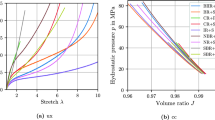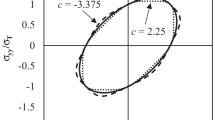Abstract
Background
Several researchers have worked on the development of effective criteria for prediction of fatigue failure in rubber. Although many of these criteria have achieved some level of success, they are restrictive in the sense that they apply only to certain loading conditions.
Objective
A new criterion was proposed to evaluate damage for antivibration design and applications so that different loading modes would not alter the fatigue prediction.
Methods
It is hypothesized that shear deformation causes fatigue damage in rubber. An effective shear strain criterion was developed by combining three principal strain ranges and verified using the published experimental results from 4 loading sets: 14 tension cases; 31 torsion cases 26 combined tension–torsion cases in phase and 19 combined tension–torsion cases out of phase. In addition, the criterion was validated against a failure of an industrial mount.
Results
The predicted cracks were located at the maximum values of the criterion, consistent with where the cracks were observed experimentally. The predicted crack orientations correlated with the experimental measurement. The obtained S–N curve covered over 102 to 2.4 × 106 cycles, achieving high accuracy with a scatter-band of 1.9 based on the 90 fatigue cases.
Conclusions
This criterion seems effective and could be used at a stage of fatigue design. In addition, it could be combined with the critical plane method: the proposed approach could be used to find hot spots, whilst the critical plane search method could be utilised locally to find the maximum values of the required damage variables.











Similar content being viewed by others
References
Benkahla J, Baranger TN, Issartel J (2013) Fatigue Life Estimation for an NBR Rubber and an Expanded Polyurethane. Exp Mech 53:1383–1393
Bourchak M, Aid A (2017) PE-HD fatigue damage accumulation under variable loading based on various damage models. Express Polym Lett 11:117–126
Luo RK, Wu WX, Cook PW, Mortel WJ (2004) An approach to evaluate the service life of rubber springs used in rail vehicle suspensions. J Rail Rapid Transit 218(2):173–177
Luo RK, Wu WX (2006) Fatigue failure analysis of anti-vibration rubber spring. Eng Fail Anal 13(1):110–116
Wu WX, Cook PW, Luo RK, Mortel WJ (2006) Fatigue Life Investigation in the Design Process of Metacone Rubber Springs, Elastomers and Components: Service Life Prediction – Progress and Challenges, edited by V. Woodhead Publishing Limited, Cambridge, England, Coveney, pp 195–207
Luo RK (2021) Effective stress criterion for rubber multiaxial fatigue under both proportional and non-proportional loadings. Eng Fail Anal 121:105172
Luo RK (2021) Multiaxial fatigue prediction on crack initiation for rubber antivibration design – location and orientation with stress ranges. J Mater Des Appl 235(3):469–480
Zerrin-ghalami T, Fatemi A (2012) Material deformation and fatigue behavior characterization for elastomeric component life predictions. Polym Eng Sci 52:1795–1805
Salma B, Adel H, Raouf F (2020) Strain-based criterion for uniaxial fatigue life prediction for an SBR rubber: Comparative study and development. J Mater Des Appl 234(7):897–909
Zerrin-ghalami T, Fatemi A (2013) Fatigue life predictions of rubber components: Applications to an automobile cradle mount. Proc Inst Mech Eng Part D J Automob Eng 227(5):691–703
Mars WV (2001) Multiaxial fatigue crack initiation in rubber. Tire Sci Technol 29:171–185
Nyaaba W, Bolarinwa EO, Frimpong S (2019) Durability prediction of an ultra-large mining truck tire using an enhanced finite element method. J Automob Eng 233:161–169
Xu X, Zhou X, Liu Y (2021) Fatigue life prediction of rubber sleeved stud shear connectors under shear load based on finite element simulation. Eng Struct 227:111449
Mars WV, Kingston JGR, Muhr A et al (2005) Fatigue life analysis of an exhaust mount. In: Austrell P and Kari L (eds) Proceedings of the 4th European conference on the constitutive models for rubber. London, Taylor and Francis, pp23–29
Shangguan WB, Zheng GF, Liu TK et al (2017) Prediction of fatigue life of rubber mounts using stressbased damage indexes. J Mater Des Appl 231:657–673
Shangguan WB, Duan X, Liu T et al (2016) Study on the effect of different damage parameters on the predicting fatigue life of rubber isolators. J Mech Eng 52:116–126
Mars WV, Fatemi A (2006) Nucleation and growth of small fatigue cracks in filled natural rubber under multiaxial loading. J Mater Sci 41:7324–7332
Mars WV, Fatemi A (2005) Multiaxial fatigue of rubber: Part II: experimental observations and life predictions. Fatigue Fract Eng Mater Struct 28:523–538
Dassault Systems (2020) Abaqus user manual. Dassault Systems
Ogden RW (1984) Non-linear elastic deformations. Ellis Horwood, Chichester, UK
Bower A (2010) Applied mechanics of solids. CRC Press, Boca Raton, FL
Luo RK (2020) Simulation methods for rubber antivibration systems. World Scientific Publishing Co Pte Ltd, Singapore
Acknowledgements
The helpful comments from both reviewers and Editors are greatly appreciated.
Author information
Authors and Affiliations
Corresponding author
Ethics declarations
Conflict of Interests
The author declares that they have no known competing financial interests or personal relationships that could have appeared to influence the work reported in this paper.
Additional information
Publisher's Note
Springer Nature remains neutral with regard to jurisdictional claims in published maps and institutional affiliations.
Rights and permissions
About this article
Cite this article
Luo, R.K. Shear Criterion and Experimental Verification for Antivibration Fatigue Design. Exp Mech 62, 537–547 (2022). https://doi.org/10.1007/s11340-021-00807-5
Received:
Accepted:
Published:
Issue Date:
DOI: https://doi.org/10.1007/s11340-021-00807-5




